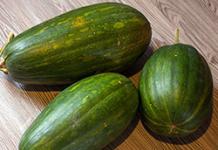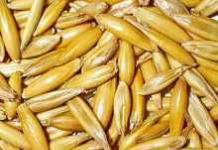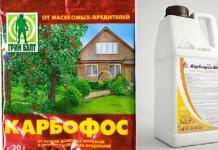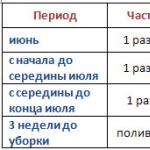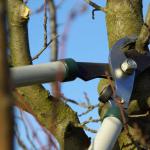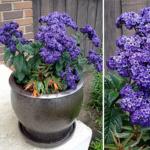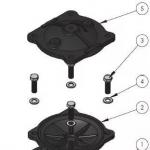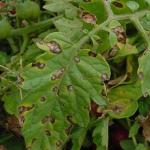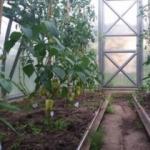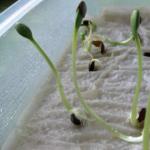Hello, dear readers! You already know that my blog has started ? Submit and get a chance to win money! And now I will paint you a gloomy picture: dark spots on the underside of the leaves slowly grow and turn brown, filling the entire leaf and smoothly moving onto the stem and fruits. The foliage dries and falls off, and the berries rot mercilessly right on the bush.
The picture is scary, isn't it? So what should I do? This disease is popularly called black rot, and all summer residents know it very well as late blight.
At the beginning of my dacha practice, I also had the opportunity to encounter this scourge, when in the blink of an eye a terrible disease mowed down a third of the plantings, and after some time the rest also “died”! So now preventative treatments are business number one when growing vegetables. The most experienced vegetable growers see this infection only in pictures, because they know how to save tomatoes from late blight. Learn this too, dear friends.
What does late blight like?
Let's start with the fact that this is a fungus, it is common among, and its spores can be everywhere - in the soil and on seeds, the compost may be contaminated, or the fungus remains on the walls of the greenhouse and the teeth of the rake.
Phytophthora loves dampness in all its manifestations, which is why it is so important to monitor the balance of soil moisture and air around the crop being grown. But moisture is not the only favorable condition for black rot.
There are also conditions, the observance of which will definitely destroy your harvest:
- Calcareous soil - some gardeners are wary of acidification and over-lime the soil, and excess lime is a good bait for fungus.
- The plantings are dense - it is difficult to ventilate the tomato jungle; late blight will immediately take advantage of this.

- Temperature changes - when it is hot during the day and cold at night, dew falls, and this is an additional source of moisture.
- Weak plants mean weak immunity, well, everything is like in people, natural selection does its job and attacks those who are least able to resist.
How to prevent or correct such situations:
- Excess lime can be compensated for with peat and sand with a coarse grain fraction.
- Crop rotation and distance between plantings should be observed.
- Watering should be done in the morning so that excess moisture evaporates during the day, and greenhouses should be ventilated. In damp or simply cloudy weather, try not to water at all; it’s easier to loosen the soil.
- Periodically spray tomatoes with preventative agents against late blight and carry out the first treatment immediately after planting the seedlings.
- Fertilize with phosphorus and potassium fertilizers in a timely manner.
Grow disease-resistant tomato varieties.
Preventive measures among the people
Spraying tomatoes to prevent late blight should be carried out on a cloudy morning, when the weather forecast does not promise precipitation, especially if late blight has already settled nearby or you have been let down by a rainy summer.
Folk remedies are very effective, such as infusion of garlic with. To do this, you need to chop 100 grams of garlic (any garlic material, not just the heads), add a glass of water and leave for a day. Then strain, dilute with 10 liters of water and add one gram of potassium permanganate to the resulting solution. Treat every 2 weeks.
A common measure is Trichopolum tablets. One tablet is dissolved in a liter of water and the culture is treated 2 times a month.
Whey, which can be bought in any store, is diluted with water one to one and, starting from the first days of July, the bushes are sprayed at least every day.
 Multitasking will help here too. You can simply dust all the earthen rows of plantings and row spacing with it before watering. Repeat these steps after fruit set.
Multitasking will help here too. You can simply dust all the earthen rows of plantings and row spacing with it before watering. Repeat these steps after fruit set.
A good remedy is an infusion of straw or hay. For one kilogram of rotten hay, add 10 liters of water, add a handful of urea and leave for up to 4 days. The strained solution is sprayed on tomato foliage every 10 days.
Milk with iodine is used against late blight. To do this, dilute 1 liter of skim milk in ten liters of water and add 15 drops of iodine. We treat the tomatoes with the mixture 2-3 times a month.
Table salt is an excellent assistant in this matter. A glass of salt is stirred in a bucket of water and large but still green fruits are processed once a month.
Two tablespoons of copper sulfate are diluted in 10 liters of water and the plants are treated once before flowering.
Dilute ordinary yeast in water 1:10 and pour it under the root at the first symptoms of the disease, immediately after the lesion.
A very long time ago, late blight prevention began to be carried out using copper wire, by piercing the trunk of a tomato bush with it.
Don't forget about the traditional. It should be diluted according to the instructions on the package, and treatment should be carried out only after the ovaries appear, and then once a week. In addition, it is worth watering the soil with phytosporin before planting or periodically adding the product to the watering tank.
Phytoharvesting in a greenhouse
To be completely safe, you can treat the greenhouse against late blight. It definitely won’t be an unnecessary action. Sanitation is carried out only after removing dirt, cobwebs and plant debris from the walls and ceiling of the greenhouse.
To fumigate a greenhouse, a piece of woolen fabric is thrown into a metal bucket with burning coals (clean wool is required here). After this, we seal the greenhouse from all sides for a day.
Extreme summer residents can put on a gauze bandage and dust the entire greenhouse with tobacco-ash dust. To obtain dust, take 2 cups of ash and a bucket of tobacco dust.
Spraying the greenhouse with a solution of microorganisms like or Radiance will be effective; Fitosporin can also be used here.
One of the best means to combat late blight remains, which can be order in the online store My-Shop.ru, and the purchase will be delivered directly to the doors of your house or apartment.

Its chemical composition is aimed at destroying pests and treating diseases in plants in early spring and during the growing season. And for the fight against fungus, it is simply excellent and allows you to treat already diseased plants.
It will not be possible to overcome late blight in one season if it has already affected the greenhouse, soil and tools. But, if you comply with all the conditions and apply the necessary measures, you can get completely healthy and beautiful tomatoes.
Happy harvest and see you soon!
With all respect, Andrew
Enter your email and receive new articles by email:

We all love fresh and canned tomatoes, in salads, ketchups, and tomato pastes. Most dishes cannot do without them. Many people buy them in markets and stores or grow them themselves in gardens and greenhouses. In principle, growing tomatoes is not so difficult, but there is one of the most common diseases of these plants - late blight, which can cause great damage to your crop. And to prevent this from happening, you need to strictly follow the rules for growing tomatoes and know the techniques for preventing and treating this disease.
What is late blight and how does it manifest itself?
Late blight on tomatoes or late blight is the so-called brown rot that affects the leaves and fruits of plants such as tomatoes, potatoes, peppers and eggplants - crops of the nightshade family. It will not be possible to fight this disease with the usual anti-fungal drugs. This disease is caused by spores that live all year round in the soil, on all devices for cultivating the garden, on old vegetable tops, on the entire surface of greenhouses, that is, everywhere you can imagine.

Treatment of tomatoes from late blight is carried out with fungicides
At the early stage of infection, late blight appears as a white coating on the bottom of the leaves, and it is very difficult to detect. But the spores of these fungi spread with lightning speed, and within 3 days you can see that the leaves and fruits of the tomatoes are covered with black spots and your harvest is lost.
Favorable conditions for the development of late blight
In dry, hot weather, late blight infection of tomatoes is minimized. The spores of this fungus do not like sunlight and are inactive. But during periods of rain and fog, when air humidity rises, they “wake up” and begin their harmful effects. If it rains for more than two days, be sure that your tomatoes have already become infected with late blight.

When growing tomatoes, overwatering is much worse than underwatering.
You create a favorable environment for fungus to live and spread if you over-water your tomato beds without giving them time to dry out. Constantly moist soil and vegetable leaves are an excellent place for spores to develop. It is worth watering the plants in the morning so that the moisture is well absorbed during the day and only at the root; the leaves should not be wetted.
Tomatoes especially often succumb to disease at the end of August, when the nights are already cool, because cold and dampness are the most important pathogens of late blight. It is important to maintain the temperature regime, so it is better to grow them in greenhouses. But even in this case, there are rules: you need to ventilate the greenhouses often so that excess condensation does not accumulate and the humidity is normal.
Other reasons for the development of late blight are:
- abuse of nitrogen fertilizers;
- lack of useful microelements copper, potassium, iodine, manganese in the soil;
- bushes and many others are too densely planted.
To prevent the development of fungal diseases, preventive measures must be taken.
Prevention of late blight on tomatoes
The best treatment is prevention, so to prevent late blight from affecting the crop, you need to implement many methods to prevent the disease:
- The first stage of prevention for the next summer's harvest begins in the fall, when the last harvest is harvested and the tops are pulled out. It must be removed from the garden and burned so that fungal spores do not infect young tomatoes a year later.
- If there is excess lime in the soil, then you need to balance its composition by pouring sand into the holes.
- You should not plant tomatoes next to other nightshade crops - potatoes, eggplants, peppers. These plants are susceptible to late blight and can cause tomato diseases.
- Before planting, the soil must be disinfected with a solution of potassium permanganate.

According to the rules of agronomy and planting technology, the soil in the greenhouse must be changed every 3-4 years
In the case of growing tomatoes in a greenhouse, it is necessary to disinfect its entire structure and the soil in it in the fall. You can do this in several ways:
- remove the top layer of soil 20 cm and start new soil;
- bury the stems of dill, marigold and calendula deep into the ground so that they rot, fertilize and heal it;
- treat the entire surface of the greenhouse with solutions of phytosporin or copper sulfate.
What else can you do
- There is an opinion that late blight does not tolerate the smell of garlic, so you need to plant garlic next to the tomatoes (between the bushes or around the beds).
- The tomatoes themselves should begin to be sprayed from the very moment the seedlings are planted. A garlic solution can serve as a preventive measure: dilute 1-2 cups of chopped garlic heads and stems in a bucket of water. Water each bush with the infused solution.
- You can sow mustard next to the tomatoes in the greenhouse; it disinfects the soil very well.
- To prevent late blight of tomatoes, you can spray them with purchased products. One of these drugs is phytosporin. This is a biological product that does not contain chemicals. The solution is easy to prepare; instructions for use are always included on the packaging. Most often this is a couple of spoons of powder per 10 liters of water. This solution should be sprayed on tomatoes every 5-14 days.
- Another preventative method for late blight on tomatoes is a solution of 1 tablespoon of copper sulfate and 1 tablespoon of washing powder per 10 liters of water. Washing powder is needed so that the copper sulfate adheres better to the leaves. This is a popular antiseptic. Late blight on tomatoes manifests itself like the flu virus on humans: if the immune system is weakened, the risk of disease increases. Therefore, you should feed the soil under the plants with useful substances - iodine, manganese, copper, potassium. In greenhouses, you can hang several bottles of iodine with open lids so that it evaporates and is absorbed into the plants. Professional gardeners claim that by inserting a piece of copper wire into the trunk of a bush above the soil itself, you can saturate the plant with the required amount of copper.
- It is necessary to promptly remove the weeds under the tomatoes and the lower leaves from the bushes so that they do not come into contact with the ground and create a ventilation effect.
Varieties without late blight
Today, many hybrid varieties of tomatoes have been developed that are practically not susceptible to late blight disease. These are varieties such as Metelitsa, Budenovka, Dragonfly, Parterre, Pink Dwarf, Raissa, Kasper, Tanya, Kostroma and others. By planting these hybrids, you can protect yourself to a greater extent than if you plant conventional varieties.

Budenovka tomatoes are resistant to late blight and fruit cracking
You can use early-ripening varieties of tomatoes, which can be harvested in mid-summer, when late blight is not yet rampant. For open land plots, the varieties Alpha, Amursky Stamb, Valentina, Vzryv, Parodist, Marisha, Sanka are suitable. Other varieties suitable for greenhouses are Sugar plum raspberry, Mandarin duck, Golden brush, Poznan, Trapeza, Sweet bunch and others.
Treatment of tomatoes for late blight
If signs of late blight appear, then you need to take urgent measures to destroy it, since before you know it, all the tomatoes will be covered in black spots.
First, you need to separate diseased plants from approximately healthy ones: remove all affected leaves and fruits or entire bushes with roots from the beds, and burn them immediately. If you grow tomatoes in a greenhouse, then you need to ventilate the room well after that, reducing the humidity.
Then it is necessary to treat the still uninfected bushes with various means so that the late blight spores die and do not spread to the rest of the tomatoes. Such products can be either purchased chemical or biological, or prepared independently.

Chemicals include Quadris, Ridomil Gold, Bravo, Ditan, Hom, boric acid, Bordeaux mixture and many others. They work very quickly, but after them there are many restrictions on the use of tomatoes. Biological products consist of inactive beneficial bacteria, which, when dissolved in water, are activated and work to destroy harmful late blight fungi on tomatoes. These are products such as Fitosporin, Gamair, Trichofit, Guapsin. After them, you can immediately eat vegetables, just after washing them well.
In the long-term fight against late blight of tomatoes, many folk remedies for this fungus were invented. Tomatoes can be treated for this disease with solutions prepared at home:
- Table salt solution: dissolve 1 glass of white crystals in 10 liters of water. Spray tomatoes only after removing all infected fruits and leaves. A protective shell is created on the bushes, which does not allow late blight to multiply.
- Iodine solution: 9 liters of water, 1 liter of any low-fat dairy product (whey can be used) and a few drops of an alcohol solution of iodine. The dairy product must be low-fat; we do not need a fatty film on the plants. Iodine saturates vegetables with the necessary beneficial microelements, and lactic acid bacteria will prevent the further development of late blight. It is necessary to spray tomatoes once a week in dry weather, starting from the appearance of the first green fruits; you can alternate iodine with brilliant green.
- Yeast solution: 100 grams of this mushroom product are dissolved in 10 liters of water. This product should be used to water the bushes as soon as the first symptoms of fungus appear.
To combat late blight in greenhouses, fumigation is used: a piece of natural animal skin or wool is placed in a container with hot coals, and all windows and doors are tightly closed. The smoke kills fungal spores and prevents them from multiplying further. They also sprinkle the beds with ash after planting and a second time at the first ovary.
Remember, it is not difficult to fight late blight; you just need to follow planting rules and prevent this disease.
Every gardener strives to protect his harvest, into which he has invested a lot of time and effort. Unfortunately, tomatoes are most susceptible to late blight, a disease that causes blackening of the fruit. As a result, the vegetable yield is significantly reduced.
The cause of late blight is infection of the plant with a specific fungus that penetrates the tomato tissue. Late blight on tomatoes appears due to a pathogen that overwintered on the remains of last year's plants. After all, with the onset of warmth, the fungus begins its new life cycle.
The infection covers the green above-ground part of the plant. Brown spots are noticeable on the leaves on top, and a white coating appears on the bottom. After some time, the leaves and stems completely turn black and die. Large brown or brown spots appear on the fruits, penetrating deep into the pulp. It is worth noting that the disease spreads quickly throughout the territory: contact with the plant on which the fungus lives is enough.
Conditions for development
Pathogenic fungi are quite tenacious and unpretentious: moisture is enough for them to function properly. And pathogens are most active in the following conditions:
- prolonged high humidity;
- temperature fluctuations: the period when dew appears on plants;
- period of heavy rains.
There is an increased risk of disease in plants during a cloudy, cool period, when dew appears on the plants in the morning. And vice versa: when the weather is dry and hot, the fungal spores die. That is, the most favorable period for late blight is the second half of summer. However, it is too late to fight the disease after global infection. It is more productive to take action when the first signs and foci of late blight appear.
Video “Prevention and methods of combating late blight”
This video material presents known methods of combating late blight, what measures need to be taken before planting, during the cultivation and ripening of plants.
Fighting methods
How to effectively combat late blight on tomatoes? It is imperative to act promptly: act against the disease when the first signs appear. If only a few plants are affected by late blight, then the main task is to eliminate them. To do this, you need to remove the infected parts of the tomatoes, take them outside the territory and burn them. Under no circumstances should such residues be added to compost!
It is also necessary to spray the plantings with systemic preparations, since contact ones may not bring the desired benefit. The following systemic fungicides are effective in the fight against late blight:
- Ridomil - easily wins the fight against infection, penetrates the plant tissue half an hour after application. Effectively protects tomatoes outside and inside for a long time. Suitable for both treatment and prevention.
- Quadris - used against diseases on tomatoes at the initial stage, including late blight. The drug is used in open ground during flowering and fruit formation at intervals of 14-16 days. In greenhouse conditions, it should be used in the vegetative phase after 7-10 days. You can consistently spray with quadris no more than 2 times. After which you should use another remedy. Quadris is able to extend fruiting by 2-3 weeks.
Plants should be treated with the above-mentioned products in the morning or evening in calm weather. Be sure to adhere to the dosage. Late varieties of tomatoes may require additional processing. Since it is in August and September, when tomatoes ripen, that a large temperature difference occurs.
Dew appears on plants, which promotes the spread and activity of late blight. During this period, the disease can be overcome only by using therapeutic agents. For example, Revus and Thanos, used during the most critical period for tomatoes.
Prevention
Tomatoes are more susceptible to late blight than other nightshades. Light fluff on the green parts of the plant retains water, which is an ideal condition for the life of the fungus that causes the disease. It is almost impossible to completely avoid late blight, as well as get rid of it. After all, the spores of the causative fungus can be stored in the ground for a long time and are easily transported by the wind over long distances.
However, you can create conditions to protect your garden as much as possible from late blight on tomatoes and minimize losses from late blight. So as not to ask the question: “How to save tomatoes from late blight?” It is necessary to carry out preventive work aimed at preventing this disease of tomatoes. Effective methods for preventing late blight are:
- Seed treatment. The spores of the causative fungus are tenacious and persist even in the hairs of the seeds. In 4 out of 5 cases, the cause of the disease is precisely infected seed. You can treat the seeds in a manganese solution: dip the seeds into it for 40 minutes through a gauze bag. Afterwards, rinse and dry. You can also soak the seeds in a solution of Fitosporin (4 drops of fungicide per 200 ml of water.

- Maintaining crop rotation. You can plant tomatoes in the same place after 3-4 years and in no case in place of their relatives: cabbage, potatoes, eggplant. You can grow tomatoes in the same place as corn, beets, onions, and zucchini.
- Elimination of plant residues. After completing the vegetative phase, you need to remove the remains of all nightshades from the garden, even without visible signs of the disease.
- Soil preparation. In open ground, you can fight against the spores of the fungal pathogen using preparations containing copper and bacterial agents (Fitosporin-M, copper sulfate). In the greenhouse, all equipment and tools must be thoroughly disinfected.
- Compliance with landing rules. You should not allow plantings to become denser, as such beds are poorly ventilated and become breeding grounds for diseases and pests.
- Growing varieties and hybrids that are immune to late blight. Most often, tomato varieties that are resistant to late blight are those that ripen early (in the first months of summer).
- Proper plant nutrition. A weak plant is an ideal breeding ground for late blight. Therefore, tomatoes need to be fed periodically.

- Optimal amount of moisture. Tomatoes need drip watering. You can also water each bush at the root.
- Treatment of plants with biological agents. Bacterial and copper-containing preparations inhibit the spread of late blight. Therefore, it is worth treating the green part of the plant with copper sulfate before flowering.
Fitosporin-M, which contains living bacterial cells, can protect against late blight on tomatoes. They are the ones who inhibit the vital activity of late blight. Another effective method for late blight on tomatoes is to spray the tomatoes with a manganese solution.
It's easy to prepare: 1 tbsp. l. Dilute liquid potassium permanganate in 10 liters of water. Plants need to be sprayed once every 2 weeks. You can also protect plants from late blight using folk remedies. For example, spray tomatoes with a liter of milk and a teaspoon of iodine diluted in a bucket of water.
Garlic tincture can also be used against late blight on tomatoes: chopped garlic (200 g) should be poured with a glass of warm water and left for 24 hours. Afterwards, strain the resulting solution, dilute with water (10 l) with the addition of a gram of manganese. Preventive treatments are carried out in dry, calm weather in the morning. The disadvantage of such sprays is their short-term effect. After rains, they must be repeated.
Late blight on tomatoes is “afraid” of ash. Therefore, in order to avoid diseases, before watering newly planted seedlings, at the beginning of fruit set, the rows of tomatoes are sprinkled with ash. Measures aimed at preventing late blight help preserve the crop and prevent the spread of the causative fungus. If there are signs of the disease in your area, do not despair and remember: you can win the fight against late blight!
 Video " Recipe for combating late blight in tomatoes»
Video " Recipe for combating late blight in tomatoes»
This video presents a natural recipe for combating late blight in tomatoes growing in open ground.
Most summer residents growing tomatoes are familiar with the problem of late blight. It is tomatoes that are more susceptible to the disease than other vegetables, which manifests itself in blackening of fruits and leaves, affecting the amount of harvest.
Late blight always lives in the soil and appears in the second half of summer, when it is already quite cold and damp at night, which means there is a good environment for its development. Now gardeners use both chemicals and various folk methods to combat the scourge. We will look at all the methods in this article.
What is late blight?
If you are not familiar with this disease, then you simply did not grow tomatoes. You need to personally know the enemy by sight, or rather the signs of the onset of late blight, in order to quickly begin the fight against it.
Late blight (or late blight) is a disease caused by a fungus. There are about 50 species of these fungi. The word “late blight” is translated as “destroying a plant.”
Fungi reproduce asexually using spores.
Fungal mycelium lives in the remains of diseased crops, in the soil, in garden tools and, having overwintered, begins its cycle anew under favorable conditions (high humidity is the most important of them).
Depending on the type of fungus itself, there are several types of late blight:
- Phytophthora cactorum Schroet. Appears on trees of the beech family (oak, beech), pine (coniferous), rosehip;
- Phytophthora cinnamomi Bonds. Trees of the beech and walnut families are affected by this fungus;
- Phytophthora infestans. The well-known late blight of potatoes and other vegetables of the nightshade family;
- Phytophthora fragariae. Raspberries, buckwheat and strawberries are affected. Recorded in North America and Europe. In Russia, cases of infection are rare.
 Late blight on tomatoes appears most often at the end of summer. In other words, it is brown rot, which first affects the leaves and then the fruits of tomatoes.
Late blight on tomatoes appears most often at the end of summer. In other words, it is brown rot, which first affects the leaves and then the fruits of tomatoes.
The leaves are covered with brown spots on the bottom.
In the rain, tomato leaves affected by late blight seem to be covered with a light-colored oil film. Tomato inflorescences turn yellow, darken and fall off.
Spots on tomato fruits of different sizes are gray-brown in color. The disease spreads throughout the entire tomato plantation quickly, literally in a couple of days. The bush quickly becomes depressed and gradually dies. Therefore, the beginning of the epidemic is easy to miss.
The first signs of late blight on tomatoes
Late blight is a fungal disease that most often affects tomatoes and potatoes; eggplant and peppers are slightly less affected by it.
Main features:
- The stem of the plant is covered with irregularly shaped brown spots;
- The inflorescences are yellow or dark and fall off quickly;
- There are dark spots on the leaves. Then the leaves dry out and fall off;
- The fruits are covered with gray-brown or black spots.
Photo of disease on tomatoes
Below you can see what the disease looks like on plants in order to recognize it in time.
How does defeat begin?
 High humidity is a trigger for the fungus that causes late blight. When moisture appears, the spores first infect the leaves, starting from the bottom.
High humidity is a trigger for the fungus that causes late blight. When moisture appears, the spores first infect the leaves, starting from the bottom.
They become covered with a white coating, which gradually passes to the upper part in the form of brown spots.
Following the leaves, the inflorescences are affected (they dry out and fall off), and then the fruits themselves. Gradually increasing spots of gray-brown color, almost black in places, cover the entire fruit.
The peel becomes thin, and the flesh begins to rot and smell unpleasant. In just a few days, the entire crop is affected by late blight, and without proper attention from the gardener it will be lost.
Causes of the disease
Before you begin to effectively combat late blight, you need to know what causes the disease. Let's look at the main ones that cause late blight on tomatoes:
- Close proximity to potatoes (most often this is where the disease begins);
- Dense plantings and lack of ventilation between bushes;
- A large difference between night and day temperatures and heavy dew in the morning (this occurs more often in August), as well as the absence of heat;
- Frequent and heavy rains in the second half of summer;
- Excessive watering in July-August during fruit ripening, as well as irrigation on the leaves;
- Excess nitrogen;
- Increased lime content in the soil;
- Lack of potassium, copper, iodine, manganese in the soil.
Knowing the main reasons, you can avoid mistakes in care in advance and save your harvest.
What to do if the disease appears in the greenhouse?
 In a greenhouse, late blight may not appear on tomatoes with proper care. The main thing is to maintain moisture and heat conditions, as well as to do preventive treatment.
In a greenhouse, late blight may not appear on tomatoes with proper care. The main thing is to maintain moisture and heat conditions, as well as to do preventive treatment.
You should not make close plantings, do not plant other tomatoes or potatoes next to the greenhouse in order to reduce the risk of transferring the disease from them to the greenhouse.
It is necessary to water rarely, but in large quantities. Prevention in a greenhouse begins with the disinfection of the premises and equipment. And if late blight gets into a greenhouse with tomatoes, then it develops even faster than in open ground: the warm and humid climate inside it contributes to this.
Measures applicable in open ground
 Tomatoes planted in open ground are most susceptible to the fungus that causes late blight.
Tomatoes planted in open ground are most susceptible to the fungus that causes late blight.
If agricultural technology has not been followed, then with increased humidity, frequent rains and large amounts of dew, late blight will definitely appear.
Here it is easier to prevent a disease than to try to fight it when it has already manifested itself. When obvious signs are visible, it is already difficult to fight it and a large loss of yield is guaranteed.
Methods and methods of struggle
 As soon as late blight appears on tomato bushes, gardeners are faced with the question of how to get rid of the scourge. There are 2 ways to treat late blight:
As soon as late blight appears on tomato bushes, gardeners are faced with the question of how to get rid of the scourge. There are 2 ways to treat late blight:
- Chemical (using drugs containing chemically active substances);
- Folk (food is often used as the main active ingredient).
Important! When processing tomatoes, it is worth processing potatoes, especially if they are planted nearby. Late blight often spreads from potatoes to tomatoes.
Fighting with chemicals
Let's look at the main, most popular drugs among summer residents and gardeners that are used to treat tomatoes.
Spraying with Hom
 Hom
is a fungicide characterized by contact action. The active ingredient is copper oxychloride, which acts on the surface and does not penetrate into the leaf and fruit.
Hom
is a fungicide characterized by contact action. The active ingredient is copper oxychloride, which acts on the surface and does not penetrate into the leaf and fruit.
It is suitable for prevention, protects the plant well, but does not treat an already diseased bush at all.
It is not able to accumulate, which means fungi do not get used to the drug and every use will be effective.
Can be processed up to 5 times per season. Lasts up to 2 weeks, but is easily washed off by rain. Last treatment at least 20 days before harvest. Prepare the solution according to the instructions, dissolving 40 g. drug per 10 liters of water. It cannot be stored. Use in the evening or morning in clear weather. Hazard class - third, requires protective clothing and safety precautions.
Treatment with Furacilin
 Furacilin is an antibacterial drug for humans. But many summer residents use it to treat late blight in tomatoes.
Furacilin is an antibacterial drug for humans. But many summer residents use it to treat late blight in tomatoes.
The solution can be prepared for the whole summer at once, because... Thanks to its bactericidal properties, it does not spoil. You need to crush 10 tablets and dilute them in 10 liters of water.
You need to spray 3 times a season: before flowering begins, when the first fruit ovaries appear, when the first tomatoes ripen. The drug is not dangerous for humans.
How to treat with Fitosporin?
 Fitosporin –
It is a biological pesticide that contains bacteria.
Fitosporin –
It is a biological pesticide that contains bacteria.
The “medicine” penetrates the plant tissue and kills all pathogenic bacteria with the help of beneficial microorganisms.
This drug is biologically safe; tomato fruits can be eaten immediately after washing thoroughly.
It combines well with other chemicals. Suitable for prevention as well as treatment. Features of preparing the solution (2 tsp per 10 liters of water):
- Use warm water no higher than 35℃;
- Do not use metal containers;
- Keep the solution in the sun for several hours to activate beneficial bacteria.
The entire plant needs to be treated. Frequency – every 10 days during the season (if it rains, then immediately after the rain). The drugs Baktofit, Baikal-EM, Fitophtorin, and Planriz have a similar bacteriological composition and method of use.
Use of Trichopolum or Metronidazole
 Trichopolum –
This is a medicine (antimicrobial and antifungal action) for people with the active ingredient metronidazole (to reduce costs, you can buy a drug with the same name).
Trichopolum –
This is a medicine (antimicrobial and antifungal action) for people with the active ingredient metronidazole (to reduce costs, you can buy a drug with the same name).
Used by gardeners not so long ago.
The solution is made as follows: 2 tablets per liter of water. Treatment - every 10 days or after rain (if tomatoes grow in open ground), since it does not linger on the leaves.
How to overcome Ordan disease?
 Ordan –
This is a fungicide with 2 active ingredients: copper chloride and cymoxanil.
Ordan –
This is a fungicide with 2 active ingredients: copper chloride and cymoxanil.
Penetrates inside the plant, a little remains on the surface.
The therapeutic effect lasts 2-4 days, and the preventive effect lasts up to 14 days.
This is where the frequency of use comes from. Prepare a solution for tomatoes as follows: 25 g. for half a bucket of water (bucket - 10 liters). The fruits should not be eaten for 5 days.
Attention! The drug Ordan has a third hazard class for humans: it requires protective equipment and measures.
Countermeasures using folk remedies
Adherents of natural farming, as well as people who use traditional methods of cultivating the land, but reject the use of chemicals when growing tomatoes, use only traditional methods of combating late blight in tomatoes. Let's look at the most popular of them.
Using whey or kefir
 Lactic acid bacteria contained in dairy products suppress the pathogenic flora of late blight.
Lactic acid bacteria contained in dairy products suppress the pathogenic flora of late blight.
It is used for preventive purposes and for treatment. The effect of different milk products is the same, although whey gives the maximum effect.
Different ratios to water: whey is diluted 1:1 (or 1:2) with water, a liter of kefir is diluted in 10 liters of water. Instead of kefir, you can take milk and add about 20 drops of iodine. Let the solution sit and then spray. The procedure can be carried out at least every day.
Soda treatment
 Soda, a product whose usual place is a kitchen cabinet, can be used for late blight in tomatoes.
Soda, a product whose usual place is a kitchen cabinet, can be used for late blight in tomatoes.
In half a bucket of water you need a tablespoon of soda and a little liquid soap for a “sticking” effect.
Repeat every week, or after rain.
Using salt to fight
 Salt can fight such scourges as late blight. After it gets on the leaves and fruits and dries, it will cover everything with a thin white layer, which will prevent fungi from entering the plant.
Salt can fight such scourges as late blight. After it gets on the leaves and fruits and dries, it will cover everything with a thin white layer, which will prevent fungi from entering the plant.
This is only a preventive measure, because... struggles on the surface. For saline solution you need 250 g. dissolve salts in a 10-liter bucket of water. Spray the entire plant. It's worth repeating after the rain.
Vinegar
 This product is often used as an anti-phytophthora remedy.
This product is often used as an anti-phytophthora remedy.
Half a glass of table vinegar (9%) should be diluted in a bucket of water and sprayed over the entire plant.
It is good to alternate this procedure with other folk and chemical methods.
Toothpaste
 This unusual method is also used by many summer residents. Toothpaste contains many substances that have a bactericidal effect.
This unusual method is also used by many summer residents. Toothpaste contains many substances that have a bactericidal effect.
To combat the disease, you need to take a tube of toothpaste and dilute it in a bucket of water.
For convenience, first stir the paste in a small amount, and then combine with the rest of the water. Toothpaste is better suited as a preventive measure. Repeat every time after rain, can be combined with other methods.
Spraying with garlic tincture
 Garlic has a strong odor and good bactericidal properties. You can plant garlic along with tomatoes.
Garlic has a strong odor and good bactericidal properties. You can plant garlic along with tomatoes.
To combat the disease, pour 1.5 cups of chopped garlic arrows and heads with 10 liters of water and leave for a day.
Afterwards you need to spray all the bushes with the solution. Needs to be repeated every 2 weeks.
Boiling water (hot water)
 The cheapest way. To do this, clean water needs to be brought to a boil and poured into a watering can with a special nozzle in the form of a shower head.
The cheapest way. To do this, clean water needs to be brought to a boil and poured into a watering can with a special nozzle in the form of a shower head.
Watering tomato bushes with hot water should be done carefully, raising the watering can higher so as not to damage the plant.
Repeat the procedure once a week.
Interesting! It has been established that spores of a harmful fungus die at temperatures above +30°C
Ash
 An ash solution effectively fights late blight on tomatoes.
An ash solution effectively fights late blight on tomatoes.
Need 5 kg. dissolve the ash in 10 liters of water and leave for 3 days, stirring regularly.
After bringing the volume of the solution to 30 liters, add any liquid soap as an “adhesive”.
Spray 3 times throughout the season: a week after planting in the ground, before flowering and after the first ovaries appear. Another way: add a glass of tobacco dust to a bucket of ash. Before use, you must wear a respirator and safety glasses.
Yeast
 An almost constant ingredient in baked goods also helps with late blight.
An almost constant ingredient in baked goods also helps with late blight.
Can be used at the first signs of tomato disease and in advance during the period of ovary appearance.
For this, 100 gr. yeast must be dissolved in a bucket of warm water, let it brew for a while and then spray the entire plant.
Hay protection
 Moreover, you need to take already rotten, rotted hay.
Moreover, you need to take already rotten, rotted hay.
About a kilogram of hay needs to be filled with 10 liters of warm water and added about 100 grams. urea.
Leave to infuse for 3 days and then treat the tomato bushes with the prepared mixture. Bacillus subtilis perfectly prevents the development of late blight.
Other ways to combat tomato late blight
There are still ways to treat tomatoes from this scourge. Let's list the main recipes that gardeners use.
Iodine treatment
 The well-known antiseptic can be used in combination with other folk remedies (milk, kefir, ash solution) for a more effective fight.
The well-known antiseptic can be used in combination with other folk remedies (milk, kefir, ash solution) for a more effective fight.
Dosage: per 10 liters of water – 20 drops of iodine.
To strengthen the immunity of plants in greenhouses, you can hang open jars of iodine.
How to treat with hydrogen peroxide?
 This is an additional source of oxygen for plants.
This is an additional source of oxygen for plants.
It has oxidizing properties and destroys the pathogenic flora of late blight.
Per liter of water you need to add 2 tbsp. hydrogen peroxide and spray the entire plant, especially the lower part of the leaves. Repeat no more than once a week.
How to protect with “Bib” for tomatoes?
This device with a “childish” name consists of covering the soil around a tomato bush with several layers of newspaper, cardboard (or mulching with previously shredded paper).
Bibs allow you to water less, because... retain moisture in the soil in sufficient quantities, which means it does not create excessive moisture. In addition, it prevents the transfer of spores from the soil to the plant itself.
Copper wire against adversity
 Copper is harmful to late blight fungus spores. A simple and effective way to combat the disease is to wrap the plant near the root collar with copper wire.
Copper is harmful to late blight fungus spores. A simple and effective way to combat the disease is to wrap the plant near the root collar with copper wire.
For better results, use a small piece of wire (about 4 cm) to pierce the stem at the base.
The ends need to be bent towards the ground. Copper from the wire will help strengthen the plant’s immunity and prevent late blight from spreading.
Important! The plant itself must already be well developed, otherwise the bush can be ruined.
Potassium permangantsovka
 This product has antiseptic properties.
This product has antiseptic properties.
It is good to use together with other folk methods (garlic, ash, milk).
Calcium chloride
Another drug from the pharmacy perfectly fights late blight fungi. It saves fruits well when the leaves are already affected. To do this, dilute calcium chloride with water in a ratio of 1:3 and process the tomato fruits.
How to stop copper sulfate infection?
 One of the most popular remedies for treating tomatoes against late blight.
One of the most popular remedies for treating tomatoes against late blight.
The main active ingredient is copper, which copes well with the scourge.
To prepare the solution, 1 tbsp. add the drug and a little liquid soap to 10 liters. water so that the drug stays on the leaves longer.
Zelenka
 An antiseptic in the amount of 40 drops per bucket of water is a good remedy for late blight in tomatoes.
An antiseptic in the amount of 40 drops per bucket of water is a good remedy for late blight in tomatoes.
Can be used for prevention and also as treatment.
Boric acid
Attention! The most effective way is to alternate the use of iodine, boric acid, brilliant green, and manganese. Frequency – once a week.
Bordeaux mixture
 Another preparation containing copper (consists of copper sulfate and quicklime).
Another preparation containing copper (consists of copper sulfate and quicklime).
To prepare the solution you need to take 100 g. copper sulfate and 150 gr. quicklime per 10 liters of water, and mix in strict sequence: first copper sulfate in water, and then lime.
The liquid is quite toxic, so you need to use protective equipment.
How to process it correctly?
 The basic processing rules are as follows:
The basic processing rules are as follows:
- The weather should be clear and calm;
- The best time is early morning or evening;
- If the drugs are toxic, then you need to use protective equipment and follow safety precautions;
- Do not use metal utensils for preparing solutions, especially chemical ones, and mixing devices (preferably plastic, glass, wood).
Varieties resistant to late blight
There are no varieties that, in principle, do not suffer from late blight. There are varieties that can resist it more than others. Most often these are hybrid varieties. For a good harvest, it is worth planting early-ripening tomatoes, the harvest of which can be harvested before massive late blight damage occurs. Varieties resistant to late blight:
- Blizzard;
- Budenovka;
- Kostroma;
- Pink dwarf;
- Parterre;
- Profitable;
- Otradny;
- Dubrava;
- Lark F1;
- De Barao;
- Berry;
- Solar;
- Grotto;
- Snezhana;
- Cameo et al.
Prevention of late blight on tomatoes
 To reduce the risk of tomatoes becoming infected with late blight and protect the harvest, you need to carry out competent agricultural practices. Basic Rules:
To reduce the risk of tomatoes becoming infected with late blight and protect the harvest, you need to carry out competent agricultural practices. Basic Rules:
- Maintaining tomato crop rotation. Do not plant tomatoes after potatoes, peppers, eggplants, avoid their close proximity. Good predecessors for tomatoes are onions, cucumbers, beets, turnips, cauliflower and carrots. Do not return tomatoes to the same bed before 4 years;
- The place for tomato plantings should be sunny;
- Choose varieties that are either early ripening or hybrid varieties that are most resistant to late blight;
- If there is a lot of lime in the soil, then add peat to the hole when planting, and then sprinkle sand around the bush. Place onion peels into the holes;
- Don't plant tomatoes too often;
- You need to water the tomatoes at the root, being careful not to touch the leaves and fruits. In the second half of summer, you don’t have to do this procedure at all (with the exception of intense heat without rain), but only regularly loosen the soil around the bush. It is better to water the plants in the morning so that excess moisture is removed during the day. Drip irrigation is ideal;
- Mulching bushes;
- Planting white mustard, calendula, marigolds, as well as onions and garlic next to tomato bushes;
- Remove shoots and unnecessary leaves in a timely manner;
- Increase the immunity of tomatoes: fertilizing with potassium and phosphorus, spraying with immunomodulators;
- Ventilate the greenhouse regularly;
- Nitrogen fertilizers are appropriate only in the first half of the growing season; the rest of the time, frequent fertilizing with nitrogen will provoke the growth of late blight.
The rules are quite simple. By following them, you can avoid massive damage to tomatoes and even not encounter late blight at all. Any disease is easier to prevent. Then your bed with tomatoes will definitely give an excellent harvest.
Important! Prevention is the best method to combat this scourge. Proper care will help preserve the harvest.
Common mistakes
Most often, the main mistakes lie in the lack of preventive measures to prevent the disease.
- During the outbreak of the disease, you should not water the bushes at all, so as not to increase the humidity.
- Another mistake is using many methods at the same time, especially chemical ones. Surely you will cope and save part of the harvest, but the plants themselves may die, and the fruits may become poisonous due to the large number of chemicals used.
FAQ
Questions about this disease arise frequently. Let's answer the most common ones:
Is it possible to water tomatoes infected with late blight?
If the weather is cloudy and the air temperature is low, it is even recommended not to water the infected bushes. You just need to loosen the soil.
Is it possible to eat tomatoes with late blight?
Tomato fruits with black spots, damaged by disease, few people will want to eat. You should not eat it, even after removing the damaged areas, because... The fungal spores have already completely penetrated the pulp of the fruit. Those tomatoes that have been affected by the fungus only on top can be eaten after heat treatment.
How to preserve fruits damaged by late blight?
You can eat good fruits from an infected bush if they are processed correctly: the fruits should be kept for 10-15 seconds in water at a temperature of 60℃. Afterwards they need to be dried and left to ripen.
How to save picked tomatoes?
Green tomatoes can be preserved for the winter after being well-treated. Red fruits are best eaten immediately or canned.
Useful video
Learn more about late blight control in the video below:
Conclusion
In conclusion, it should be said that the most important thing in treating tomatoes from late blight is prevention. If you take all preventive measures, then problems with this scourge can be avoided.
Which method to choose to treat tomatoes from late blight is a personal matter for each gardener. None of the listed methods guarantees complete relief from the disease. To effectively combat the onset of a tomato disease, it is better to alternate methods and methods so that the fungus does not get used to it and does not develop immunity to the drugs.
In contact with




